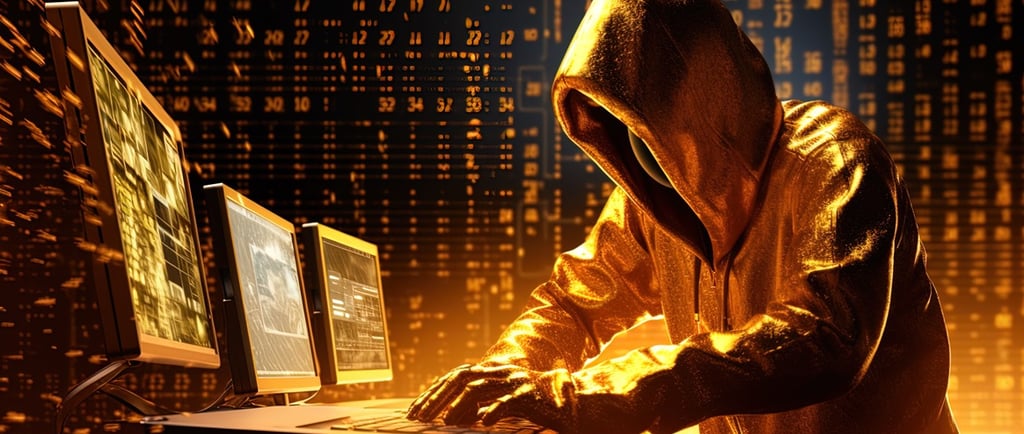How Can You Feel Safe When US Giants are Falling to International Hackers?
In a world where digital shadows loom large, not even the titans of U.S. industry stand unassailable. How can you protect your organization?
GENERAL BUSINESS TOPICSGENERAL TOPICSSOCIAL COMMENTARY


In the ever-evolving landscape of cyberspace, even the mightiest giants aren’t safe from the stealthy approach of state-sponsored hackers. From disrupting our daily cup of joe to threatening national security, these cyber incursions reveal a broad spectrum of vulnerabilities.
Let’s journey through a rogues’ gallery of American entities that have faced the digital storm.
1. SolarWinds - The Invisible Sting (2020)
In a sophisticated cyber espionage campaign, hackers infiltrated SolarWinds, a software company based in Tulsa, Oklahoma, affecting thousands of their clients, including government agencies and Fortune 500 companies, by inserting malicious code into their Orion software.
This sophisticated supply chain attack affected numerous U.S. government agencies and thousands of businesses. The U.S. government and cybersecurity experts attributed the attack to Russian state-sponsored hackers, underscoring the vulnerability of global supply chains to cyber espionage.
2. Microsoft - The Colossus Breached (2024)
Microsoft, a technology titan, was targeted by hackers backed by Russia in a sophisticated cyberattack. These hackers, associated with Russia's foreign intelligence, used data stolen from corporate emails in January to exploit vulnerabilities in Microsoft's Exchange email servers. This breach compromised the security of tens of thousands of organizations globally and marked another attempt to infiltrate the tech giant. Microsoft's products are extensively utilized throughout the US national security establishment, making this breach particularly significant.
3. Equifax - The Great Exposure (2017)
The massive Equifax data breach exposed the personal information of about 147 million people, highlighting the significant risk hackers pose to financial institutions. The compromised data included first and last names, Social Security numbers, birth dates, addresses, and, in some cases, driver's license numbers of approximately 143 million Americans. Additionally, the personal information of nearly 14 million British residents was also affected, according to Equifax's analysis.
4. Sony Pictures - The Plot Twist (2014)
In an attack that seemed straight out of a movie, Sony Pictures experienced a devastating cyberattack attributed to North Korean hackers, crippling their network and leaking confidential data.
The U.S. government attributed this cyber-attack to North Korea. Hackers breached Sony Pictures' network, leaked confidential data, destroyed files, and incapacitated thousands of computers in retaliation for the company's release of "The Interview," a comedy film that depicted a fictional assassination of North Korea's leader.
5. JBS USA - When Meat Went Digital (2021)
JBS USA, the world's largest meat processor, paid an $11 million ransom to cyber attackers to mitigate potential risks to its customers, a move described by CEO Andre Nogueira as a "very difficult decision." This incident, targeting the company's U.S. and Australian servers, underscores the vulnerability of the food industry to cyber threats. The FBI identified the Russian-speaking gang REvil as the culprit behind this and several other high-profile ransomware attacks, including one on Colonial Pipeline (described below). This earlier attack led to widespread panic-buying of gasoline across the South and East Coast after Colonial temporarily shut down its operations and paid a $4.4 million ransom.
6. Colonial Pipeline - The Flow Stops (2021)
The Colonial Pipeline, the largest fuel pipeline in the U.S., suffered a ransomware attack in May 2021, causing a significant shutdown that led to temporary fuel shortages across the East Coast. The cyberattack, suspected to be perpetrated by "DarkSide" - a cybercriminal hacking group believed to be based in Russia, disrupted nearly half the East Coast's fuel supply, compelling Colonial Pipeline to pay a ransom of over $4 million to resume operations. CEO Joe Blount regarded the payment as "the right decision for the country" to quickly restore the fuel supply. Despite the company's swift response to pay the ransom and restart the pipeline within six days, panic-buying ensued, resulting in temporary fuel outages in 11 states and Washington, DC Several governors declared states of emergency and advised against hoarding gas during the crisis.
7. Yahoo - The Data Deluge (2014 - 2016)
Yahoo’s revelation of two massive data breaches affecting a billion users underscored the vast potential for damage in the tech sector, laying the groundwork for concerns over user data protection.
8. Marriott International - Unwelcome Guests (2020)
Marriott International disclosed a security breach affecting up to 500 million guests, spotlighting the hospitality industry’s vulnerabilities to cyber espionage.
9. Anthem - Healthcare Held Hostage (2014)
The health insurance giant Anthem suffered a data breach that exposed over 80 million customers' personal information. This breach, linked to Chinese espionage efforts, highlights the critical need for robust cybersecurity measures in the healthcare sector.
10. Democratic National Committee (DNC) - The Political Chess Game (2016)
The DNC’s email system was compromised during the 2016 election cycle, a stark reminder of how cyberattacks can play pivotal roles in political arenas.
Russian government-affiliated hackers were accused of infiltrating the DNC's computer network, stealing sensitive documents, and leaking them to influence the U.S. presidential election in 2016. This event has had lasting implications for U.S.-Russia relations and raised concerns about the security of electoral systems.
11. Twitter - The High-Profile Hijack (2020 - 2023)
In a startling breach, high-profile Twitter accounts were hijacked to promote a cryptocurrency scam, demonstrating the potential for social media platforms to be exploited.
12. FireEye - The Protector Penetrated (2020)
FireEye, a top cybersecurity firm, experienced a significant breach, ironically underscoring that even the guardians of cyberspace are not immune to attacks.
13. OPM (Office of Personnel Management) (2015)
Chinese hackers accessed sensitive information on millions of federal employees, including fingerprints and security clearance data, in a breach that shook the U.S. government to its core.
14. JPMorgan Chase (2014)
In a massive financial breach, the information of over 76 million households was compromised by a cyberattack thought to be linked to a foreign government, underscoring the financial sector's cyber risks.
15. Google (Operation Aurora, 2010)
In an ambitious cyber espionage campaign originating from China, Google and numerous other companies were targeted, signaling the dawn of state-sponsored cyberattacks against U.S. tech giants.
16. Sandia National Laboratories (1999)
In an early instance of digital espionage, this U.S. Department of Energy lab was targeted by hackers believed to be working for the Chinese government, stealing nuclear secrets and underscoring the long history of cyber warfare.
Beyond the USA
1. WannaCry Ransomware Attack (2017)
The WannaCry ransomware attack affected hundreds of thousands of computers across 150 countries, disrupting healthcare systems, corporations, and government agencies. The U.S., UK, and others attributed the attack to hackers affiliated with North Korea, highlighting the global threat of ransomware attacks linked to state actors.
2. NotPetya (2017)
Originating in Ukraine and spreading globally, NotPetya was a destructive malware attack that targeted businesses, governments, and infrastructure. The U.S. and other countries attributed the attack to the Russian military, framing it as part of ongoing geopolitical conflicts. NotPetya caused billions of dollars in damages, affecting companies worldwide.
3. Ukraine Power Grid Attack (2015)
Considered the first successful cyber-attack on a power grid, this incident left hundreds of thousands of Ukrainians without electricity. Security experts have attributed the attack to Russian state-sponsored hackers, marking a significant escalation in cyber warfare tactics.
Yes, the US Can Also Hack
The Stuxnet Worm (2010)
The Stuxnet worm event marks a watershed moment in cybersecurity history, emerging around 2010 as a highly sophisticated piece of malware believed to have been jointly developed by the United States and Israel. Designed to sabotage Iran's nuclear program, Stuxnet specifically targeted Siemens industrial control systems used in uranium enrichment facilities, causing the fast-spinning centrifuges to tear themselves apart.
This cyberweapon's discovery heralded a new era in cyber warfare, showcasing the potential for digital attacks to inflict physical damage on critical infrastructure and highlighting the vulnerabilities of even the most secure systems to state-sponsored hacking efforts.
Fortifying the Digital Fortress: Safeguarding Against the Unseen Enemy
In the wake of these stark reminders of vulnerability, U.S. companies and organizations must adopt a vigilant stance, bolstering their defenses against the specters of cyberspace. Here’s how they can shield themselves:
Embrace Comprehensive Security Practices: Implementing a multi-layered security approach, including firewalls, intrusion detection systems, and rigorous access controls, forms the bedrock of defense.
Stay Vigilant with Updates and Patches: Regularly updating software and systems can close the doors that hackers often slip through.
Cultivate a Culture of Cybersecurity Awareness: Educating employees about the dangers of phishing and social engineering attacks empowers the human element in cybersecurity.
Deploy Encryption Wisely: Encrypting sensitive data, both at rest and in transit, can significantly reduce the impact of a breach.
Develop and Drill Incident Response Plans: Having a well-practiced response plan ensures an organization can swiftly mitigate damage and recover from breaches.
Leverage Threat Intelligence: Staying informed about emerging threats enables organizations to adapt their defenses proactively.
Audit and Assess: Regular security assessments and penetration testing can uncover vulnerabilities before they are exploited.
In the shadowy realm of cyber warfare, knowledge, preparedness, and resilience are the keys to safeguarding the digital domain. By learning from past breaches and fortifying their defenses, U.S. companies and organizations can stand strong against the advancing tide of state-sponsored cyber threats, ensuring that the digital heartbeat of America continues to pulse with vigor and vitality.
Free tree backgrounds from pikbest.com https://pikbest.com/free-backgrounds/tree.html



